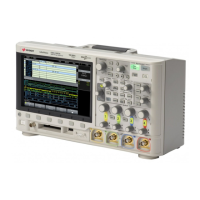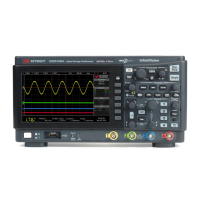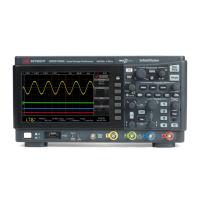216 Keysight InfiniiVision 3000T X-Series Oscilloscopes User's Guide
13 Acquisition Control
The [Single] run control lets you view single-shot events without subsequent
waveform data overwriting the display. Use [Single] when you want maximum
memory depth for pan and zoom.
When you press [Single], the trigger mode is temporarily set to Normal (to keep
the oscilloscope from auto-triggering immediately), the trigger circuitry is
armed, the [Single] key is illuminated, and the oscilloscope waits until a trigger
condition occurs before it displays a waveform.
When the oscilloscope triggers, the single acquisition is displayed and the
oscilloscope is stopped (the [Run/Stop] key is illuminated in red). Press [Single]
again to acquire another waveform.
If the oscilloscope doesn't trigger, you can press the [Force Trigger] key to trigger
on anything and make a single acquisition.
To display the results of multiple acquisitions, use persistence. See “To set or
clear persistence" on page 157.
Single vs. Running
and Record Length
The maximum data record length is greater for a single acquisition than when the
oscilloscope is running (or when the oscilloscope is stopped after running):
• Single — Single acquisitions always use the maximum memory available — at
least twice as much memory as acquisitions captured when running — and the
oscilloscope stores at least twice as many samples. At slower time/div settings,
because there is more memory available for a single acquisition, the acquisition
has a higher effective sample rate.
• Running — When running (versus taking a single acquisition), the memory is
divided in half. This lets the acquisition system acquire one record while
processing the previous acquisition, dramatically improving the number of
waveforms per second processed by the oscilloscope. When running, a high
waveform update rate provides the best representation of your input signal.
To acquire data with the longest possible record length, press the [Single] key.
For more information on settings that affect record length, see “Length
Control" on page 326.
